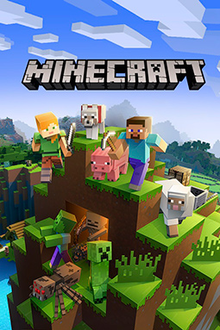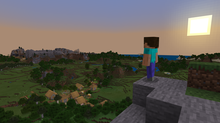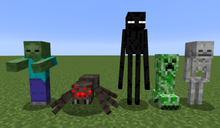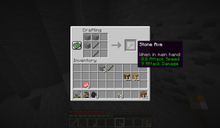Minecraft is a sandbox video game developed by Mojang. The game was created by Markus "Notch" Persson in the Java programming language. Following several early test versions, it was released as a paid public alpha for personal computers in 2009 before releasing in November 2011, with Jens Bergensten taking over development. Minecraft has since been ported to several other platforms and is the best-selling video game of all time, with 200 million copies sold and 126 million monthly active users as of 2020.
In Minecraft, players explore a blocky, procedurally-generated 3D world with virtually infinite terrain, and may discover and extract raw materials, craft tools and items, and build structures or earthworks. Depending on game mode, players can fight computer-controlled "mobs", as well as cooperate with or compete against other players in the same world. Game modes include a survival mode, in which players must acquire resources to build the world and maintain health, and a creative mode, where players have unlimited resources. Players can modify the game to create new gameplay mechanics, items, and assets.
Minecraft has been critically acclaimed, winning several awards and being cited as one of the greatest video games of all time. Social media, parodies, adaptations, merchandise, and the annual MineCon conventions played large roles in popularizing the game. It has also been used in educational environments, especially in the realm of computing systems, as virtual computers and hardware devices have been built in it. In 2014, Mojang and the Minecraft intellectual property were purchased by Microsoft for US$2.5 billion. A number of spin-off games have also been produced, such as Minecraft: Story Mode, Minecraft Dungeons, and Minecraft Earth.

Gameplay
Minecraft is a 3D sandbox game that has no specific goals to accomplish, allowing players a large amount of freedom in choosing how to play the game.[18] However, there is an achievement system,[19] known as "advancements" in the Java Edition of the game, and "trophies" on the PlayStation ports.[20] Gameplay is in the first-person perspective by default, but players have the option for third-person perspective.[21] The game world is composed of rough 3D objects—mainly cubes and fluids, and commonly called "blocks"—representing various materials, such as dirt, stone, ores, tree trunks, water, and lava. The core gameplay revolves around picking up and placing these objects. These blocks are arranged in a 3D grid, while players can move freely around the world. Players can "mine" blocks and then place them elsewhere, enabling them to build things.[22] Many commentators have described the game's physics system as unrealistic.[23] The game also contains a material known as redstone, which can be used to make primitive mechanical devices, electrical circuits, and logic gates, allowing for the construction of many complex systems.

The game world is virtually infinite and procedurally generated as players explore it, using a map seed that is obtained from the system clock at the time of world creation (or manually specified by the player).[25][26][27] There are limits on vertical movement, but Minecraft allows an infinitely large game world to be generated on the horizontal plane. Due to technical problems when extremely distant locations are reached, however, there is a barrier preventing players from traversing to locations beyond 30,000,000 blocks from the center.[i] The game achieves this by splitting the world data into smaller sections called "chunks" that are only created or loaded when players are nearby.[25] The world is divided into biomes ranging from deserts to jungles to snowfields;[28][29] the terrain includes plains, mountains, forests, caves, and various lava/water bodies.[27] The in-game time system follows a day and night cycle, and one full cycle lasts 20 real-time minutes.
When starting a new world, players must choose one of five game modes, as well as one of four difficulties, ranging from peaceful to hard. Increasing the difficulty of the game causes the player to take more damage from mobs, as well as having other difficulty-specific effects. For example, the peaceful difficulty prevents hostile mobs from spawning, and the hard difficulty allows players to starve to death if their hunger bar is depleted.[30] Once selected, the difficulty can be changed, but the game mode is locked and can only be changed with cheats.

New players have a randomly selected default character skin of either Steve or Alex,[31] but the option to create custom skins was made available in 2010.[32] Players encounter various non-player characters known as mobs, such as animals, villagers, and hostile creatures.[33] Passive mobs, such as cows, pigs, and chickens, can be hunted for food and crafting materials. They spawn in the daytime, while hostile mobs—including large spiders, skeletons, and zombies—spawn during nighttime or in dark places such as caves.[27] Some hostile mobs, such as zombies, skeletons and drowned (underwater versions of zombies), burn under the sun if they have no headgear.[34] Other creatures unique to Minecraft include the creeper (an exploding creature that sneaks up on the player) and the enderman (a creature with the ability to teleport as well as pick up and place blocks).[35] There are also variants of mobs that spawn in different conditions; for example, zombies have husk variants that spawn in deserts.[36]
Minecraft has two alternative dimensions besides the overworld (the main world): the Nether and the End.[35] The Nether is a hell-like dimension accessed via player-built portals; it contains many unique resources and can be used to travel great distances in the overworld, due to every block traveled in the Nether being equivalent to 8 blocks traveled in the overworld.[37] The player can build an optional boss mob called the Wither out of materials found in the Nether.[38] The End is a barren land consisting of many islands. A boss dragon called the Ender Dragon dwells on the main island.[39] Killing the dragon opens access to an exit portal, which upon entering cues the game's ending credits and a poem written by Irish novelist Julian Gough.[40] Players are then teleported back to their spawn point and may continue the game indefinitely.
Game modes
Survival mode
In survival mode, players have to gather natural resources such as wood and stone found in the environment in order to craft certain blocks and items.[27] Depending on the difficulty, monsters spawn in darker areas outside a certain radius of the character, requiring players to build a shelter at night.[27] The mode also has a health bar which is depleted by attacks from mobs, falls, drowning, falling into lava, suffocation, starvation, and other events.[citation needed] Players also have a hunger bar, which must be periodically refilled by eating food in-game, except in peaceful difficulty.[citation needed] If the hunger bar is depleted, automatic healing will stop and eventually health will deplete. Health replenishes when players have a nearly full hunger bar or continuously on peaceful difficulty.
Players can craft a wide variety of items in Minecraft.[42] Craftable items include armor, which mitigates damage from attacks; weapons (such as swords or axes), which allows monsters and animals to be killed more easily; and tools, which break certain types of blocks more quickly. Some items have multiple tiers depending on the material used to craft them, with higher-tier items being more effective and durable. Players can construct furnaces, which can cook food, process ores, and convert materials into other materials.[43] Players may also exchange goods with a villager (NPC) through a trading system, which involves trading emeralds for different goods and vice versa.[44][33]
The game has an inventory system, allowing players to carry a limited number of items.[45] Upon dying, items in the players' inventories are dropped unless the game is reconfigured not to do so. Players then re-spawn at their spawn point, which by default is where players first spawn in the game, and can be reset by sleeping in a bed[46] or using a respawn anchor.[47][48] Dropped items can be recovered if players can reach them before they disappear or despawn after 5 minutes. Players may acquire experience points by killing mobs and other players, mining, smelting ores, breeding animals, and cooking food. Experience can then be spent on enchanting tools, armor and weapons.[30] Enchanted items are generally more powerful, last longer, or have other special effects.

Hardcore mode
Hardcore mode is a survival mode variant that is locked to the hardest setting and has permadeath.[49] If a player dies in a hardcore world, they are no longer allowed to interact with it, so they can either be put into spectator mode and explore the world or delete it entirely.[50] This game mode can only be accessed within the Java Edition.
Creative mode
A large building appearing to be a city hall or a courthouse.
An example of a creation constructed in Minecraft
In creative mode, players have access to nearly all resources and items in the game through the inventory menu, and can place or remove them instantly. Players can toggle the ability to fly freely around the game world at will, and their characters do not take any damage and are not affected by hunger. The game mode helps players focus on building and creating projects of any size without disturbance.
Adventure mode
Adventure mode was designed specifically so that players could experience user-crafted custom maps and adventures. Gameplay is similar to survival mode but with various restrictions, which can be applied to the game world by the creator of the map. This forces players to obtain the required items and experience adventures in the way that the map maker intended.[57] Another addition designed for custom maps is the command block; this block allows map makers to expand interactions with players through scripted server commands.
Spectator mode
Spectator mode allows players to fly through blocks and watch gameplay without directly interacting. Players do not have an inventory, but can teleport to other players and view from the perspective of another player or creature.
Multiplayer
Multiplayer in Minecraft enables multiple players to interact and communicate with each other on a single world. It is available through direct game-to-game multiplayer, LAN play, local split screen (console-only), and servers (player-hosted and business-hosted).[60] Players can run their own servers, use a hosting provider, or connect directly to another player's game via Xbox Live. Single-player worlds have local area network support, allowing players to join a world on locally interconnected computers without a server setup.[61] Minecraft multiplayer servers are guided by server operators, who have access to server commands such as setting the time of day and teleporting players. Operators can also set up restrictions concerning which usernames or IP addresses are allowed or disallowed to enter the server.[60] Multiplayer servers have a wide range of activities, with some servers having their own unique rules and customs. The largest and most popular server is Hypixel, which has been visited by over 14 million unique players.[62][63] Player versus player combat (PvP) can be enabled to allow fighting between players.[64] Many servers have custom plugins that allow actions that are not normally possible.
Minecraft Realms
In 2013, Mojang announced Minecraft Realms, a server hosting service intended to enable players to run server multiplayer games easily and safely without having to set up their own.[65][66] Unlike a standard server, only invited players can join Realms servers, and these servers do not use IP addresses. Minecraft: Java Edition Realms server owners can invite up to twenty people to play on their server, with up to ten players online at a time. Minecraft Realms server owners can invite up to 3000 people to play on their server, with up to ten players online at one time.[67] The Minecraft: Java Edition Realms servers do not support user-made plugins, but players can play custom Minecraft maps.[68] Minecraft Realms servers support user-made add-ons, resource packs, behavior packs, and custom Minecraft maps.[67] At Electronic Entertainment Expo 2016, support for cross-platform play between Windows 10, iOS, and Android platforms was added through Realms starting in June 2016,[69] with Xbox One and Nintendo Switch support to come later in 2017,[70] and support for virtual reality devices. On 31 July 2017, Mojang released the beta version of the update allowing cross-platform play.[71] Nintendo Switch support for Realms was released in July 2018.[72]
Customization
The modding community consists of fans, users and third-party programmers. Using a variety of application program interfaces that have arisen over time, they have produced a wide variety of downloadable content for Minecraft, such as modifications, texture packs and custom maps. Modifications of the Minecraft code, called mods, add a variety of gameplay changes, ranging from new blocks, new items, new mobs to entire arrays of mechanisms to craft.[73][74] The modding community is responsible for a substantial supply of mods from ones that enhance gameplay, such as minimaps, waypoints, and durability counters, to ones that add to the game elements from other video games and media.
While a variety of mod frameworks were independently developed by reverse engineering the code, Mojang has also enhanced vanilla Minecraft with official frameworks for modification, allowing the production of community-created resource packs, which alter certain game elements including textures and sounds.[75] Players can also create their own "maps" (custom world save files) which often contain specific rules, challenges, puzzles and quests, and share them for others to play.[55] Mojang added an adventure mode in August 2012[56] and "command blocks" in October 2012,[58] which were created specially for custom maps in Java Edition. Data packs, introduced in version 1.13 of the Java Edition, allow further customization, including the ability to add new advancements, dimensions, functions, loot tables, predicates, recipes, structures, tags, world generation settings, and biomes.[76][77]
The Xbox 360 Edition supports downloadable content, which is available to purchase via the Xbox Games Store; these content packs usually contain additional character skins.[78] It later received support for texture packs in its twelfth title update while introducing "mash-up packs", which combines texture packs with skin packs and changes to the game's sounds, music and user interface.[79] The first mash-up pack (and by extension, the first texture pack) for the Xbox 360 Edition was released on 4 September 2013, and was themed after the Mass Effect franchise.[80] Unlike Java Edition, however, the Xbox 360 Edition does not support player-made mods or custom maps.[81] A cross-promotional resource pack based on the Super Mario franchise by Nintendo was released for the Wii U Edition worldwide on 17 May 2016.[82] A mash-up pack based on Fallout was announced for release on the Wii U Edition.[83] In April 2018, malware was discovered in several downloadable user-made Minecraft skins for use with the Java Edition of the game.[84][85] Avast stated that nearly 50,000 accounts were infected, and when activated, the malware would attempt to reformat the user's hard drive.[85][84] Mojang promptly patched the issue, and released a statement stating that "the code would not be run or read by the game itself",[84] and would only run when the image containing the skin itself was opened.
In June 2017, Mojang released an update known as the "Discovery Update" to the Bedrock version of the game.[87] The update includes a new map, a new game mode, the "Marketplace", a catalogue of user-generated content that gives Minecraft creators "another way to make a living from the game", and more.
Development
Java Edition
Before coming up with Minecraft, Markus "Notch" Persson was a game developer with King through March 2009, at the time serving mostly browser games, during which he learnt a number of different programming languages.[91] He would prototype his own games during his off-hours at home, often based on inspiration he found from other games, and participated frequently on the TIGSource forums for independent developers.[91] One of these personal projects was called "RubyDung", a base-building game inspired by Dwarf Fortress, but as an isometric three dimensional game like RollerCoaster Tycoon.[92] He had already made a 3D texture mapper for another zombie game prototype he had started to try to emulate the style of Grand Theft Auto: Chinatown Wars.[93] Among the features in "RubyDung" he explored was a first-person view similar to Dungeon Keeper but at the time, felt the graphics were too pixelated and omitted this mode.[93][94] Around March 2009, Persson left King and joined jAlbum, but otherwise kept working on his prototypes.[95][94][96]
Infiniminer, a block-based open-ended mining game first released in April 2009, sparked Persson's inspiration for how to take "RubyDung" forward.[93] Infiniminer heavily influenced the visual style of gameplay, including bringing back the first-person mode, the "blocky" visual style and the block-building fundamentals.[93] However, unlike Infiniminer, Persson wanted Minecraft to have RPG elements.[97]
The original edition of Minecraft, now known as the Java Edition, was first developed in May 2009. Persson released a test video on YouTube of an early version of Minecraft.[93][98] The base program of Minecraft was completed by Persson over a weekend in that month and a private testing was released on TigIRC on 16 May 2009.[99] The game was first released to the public on 17 May 2009 as a developmental release on TIGSource forums.[100] Persson updated the game based on feedback from the forums.[91][101] This version later become known as the Classic version.[102] Further developmental phases dubbed as Survival Test, Indev and Infdev were released between September 2009 and June 2010.[citation needed]
The first major update, dubbed Alpha, was released on 30 June 2010.[103][104] Although Persson maintained a day job with Jalbum.net at first, he later quit in order to work on Minecraft full-time as sales of the alpha version of the game expanded.[105] Persson continued to update the game with releases distributed to users automatically. These updates included new items, new blocks, new mobs, survival mode, and changes to the game's behavior (e.g. how water flows).[105] To back the development of Minecraft, Persson set up a video game company, Mojang, with the money earned from the game.[106][107][108] Mojang co-founders included Jakob Porser, one of Persson's coworkers from King, and Carl Manneh, jAlbum's CEO.[91]
On 11 December 2010, Persson announced that Minecraft was entering its beta testing phase on 20 December 2010.[109] He further stated that bug fixes and all updates leading up to and including the release would still be free.[110] Over the course of the development, Mojang hired several new employees to work on the project.[111]
Mojang moved the game out of beta and released the full version on 18 November 2011.[112] On 1 December 2011, Jens "Jeb" Bergensten took full creative control over Minecraft, replacing Persson as lead designer.[113] On 28 February 2012, Mojang announced that they had hired the developers of the popular "Bukkit" developer API for Minecraft,[64] to improve Minecraft's support of server modifications.[114] This acquisition also included Mojang apparently taking full ownership of the CraftBukkit server mod which enables the use of Bukkit,[115] although the validity of this claim was questioned due to its status as an open-source project with many contributors, licensed under the GNU General Public License and Lesser General Public License.[116]
On 15 September 2014, Microsoft announced a $2.5 billion deal to buy Mojang, along with the ownership of the Minecraft intellectual property.[117][118][119] The deal was suggested by Persson when he posted a tweet asking a corporation to buy his share of the game after receiving criticism for changing the game's end user license agreement (EULA).[120][121] It was arbitrated on 6 November 2014, and led to Persson becoming one of Forbes' "World's Billionaires". The original version of the game was renamed to Minecraft: Java Edition on 18 September 2017 to separate it from Bedrock Edition, which was renamed to just Minecraft by the Better Together Update.[126]
Since the first full release of Minecraft, dubbed the "Adventure Update", the game has been continuously updated with many major updates, available for free to users who have already purchased the game.[127] The latest update is 1.16, the "Nether Update", which overhauls the Nether dimension, adding new biomes and mobs, and was released on 23 June 2020.[128] The next planned update, "Caves & Cliffs", is set to be released in two parts in mid- and late 2021,[129] and will expand the game's underground biomes with more types of blocks and mobs and revamp mountainous world generation.[130]
The Bedrock Edition has also been regularly updated, with these updates now matching the themes of Java Edition updates. Other versions of the game such as the various console editions and Pocket Edition were either merged into Bedrock and/or discontinued and as such have not received further updates.